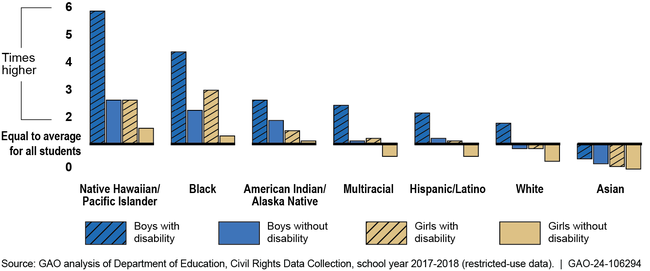
Share this story
|
|
A review published this month from the Government Accountability Office (GAO) found higher referral and arrest rates for students of color and with learning differences.
Research was done in response to growing concerns about police presence in schools and possible discrimination against students in different subgroups, the accountability office said. The report, which was released July 8, found higher incident rates for different subgroups and for students who belong to more than one. However, data limitations caused calls for more research and changes from the Department of Education.
The Office of Civil Rights, under the department, is responsible for surveying K-12 schools each year. The Civil Rights Data Collection (CRDC) is meant to help make sure students are getting equal opportunities to education. According to the report, the data is an important tool for schools, families, policymakers, and others concerned about disparities.
“Our analysis and Education’s own guidance recognize that students can experience even greater adverse consequences as their race, gender and disability statuses overlap, but OCR does not collect sufficiently detailed data that could help it determine whether students receiving services under section 504 of the rehabilitation act of 1973 as amended are potentially being treated unfairly,” the report said.
The analysis drew from the department’s data collected from nearly every United States school district. They reviewed two CRDC datasets for the two most recent school years before the pandemic (2015–16 and 2017–18) and 2019–20. While researching, they also visited three school districts based on factors such as high rates of arrests. Researchers also reviewed federal laws and regulations and interviewed federal officials and representatives of national education and civil rights groups.
According to the report, students who identified as Native Hawaiian/Pacific Islander, Black, and American Indian/Alaska Native were arrested two to three times more than white students. Males in the same groups who also had learning differences were reprimanded even more often.
There are two different plans for students who receive accommodations in school. One is an Individual Education Plan (IEP), and another is known as the 504 plan. An IEP is covered by the Individuals with Disabilities in Education Act. A 504 plan refers to section 504 of the Rehabilitation Act of 1973, which prohibits discrimination against people with disabilities from entities that receive federal funding, such as a school. IEP plans cover students who qualify for special education. Meanwhile, section 504 helps students who don’t meet the criteria for special education but still require some accommodations.
There were twice as many arrests and referrals for students with IEPs compared to those without, the report said. The report also said students who received 504 services alone had 1.5 times more incidents.
Guidance from the department said that when race, gender, and disability statuses intersect, students might experience discrimination due to “the combination of protected characteristics.” With that said, it does not collect arrest and referral data by race for students receiving services only under Section 504 of the Rehabilitation Act of 1973.
Students were arrested twice as much in schools with a police presence than those without, per the GAO analysis. More than half of schools have a police officer present at least once a week, according to the report. Among those buildings, the analysis found that arrests were more common when officers were involved in student discipline.
The department changed the definition of arrest for the 2021–22 school year. School districts did not know about the new definition before they collected the data. There is a chance that the districts used the old definition, which could affect how accurate the data is.
In the analysis, researchers highlighted how the data only recorded arrests and referrals by race and ethnicity for students without disabilities and those with IEPs. This excluded students who only receive services under section 504 of the Rehabilitation Act, which can cause the decrease of recorded incidents of arrests and referrals by race.
The report concluded with three recommendations. First, the accountability office suggested that the department collect arrest and referral data by race for students with disabilities who receive services under Section 504. They also recommended that the department disclose the limitations of its 2021–22 arrest data. Lastly, they asked for a clear notice to be sent out to school districts about future changes to arrest and referral data in its civil rights data collection. The department generally agreed with these recommendations, the report said.
In their response, the department said they are concerned about the privacy of students being served under section 504 in data disaggregated by race.
“For example, in the 2020-21 CRDC, schools reported about 3,100 504-only students were referred to law enforcement and less than 600 504-only students received an arrest,” the department said. “Reporting these data at the school level disaggregated by race would yield small cell counts that could not be released without risking the disclosure of identifying information.”
The report does mention that referrals and arrests are generally rare. However, for certain racial groups, such as Asian students, over 95% of schools reported zero arrests or referrals, the report said.
Due to the length of the process it takes to make changes to the data collection, it is expected that nothing recommended from the report would be reflected until the 2025-26 CRDC.





